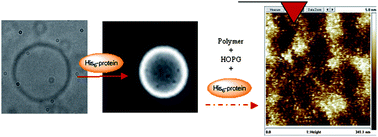Protein decorated membranes by specific molecular interactions†
Abstract
Here we characterize new metal-functionalized amphiphilic

* Corresponding authors
a
Department of Chemistry, University of Basel, Klingelbergstrasse 80, Basel, Switzerland
E-mail:
Wolfgang.Meier@unibas.ch
Fax: +41 (0)61 267 3850
Tel: +41 (0)61 267 3802
b CIC BiomaGUNE—Biosurfaces unit, Paseo Miramón 182, San Sebastián, Spain
c BAM—Federal Institute for Materials Sciences and Testing, Richard Willstätterstraße 11, Berlin, Germany
Here we characterize new metal-functionalized amphiphilic

 Please wait while we load your content...
Something went wrong. Try again?
Please wait while we load your content...
Something went wrong. Try again?
R. Nehring, C. G. Palivan, S. Moreno-Flores, A. Mantion, P. Tanner, J. L. Toca-Herrera, A. Thünemann and W. Meier, Soft Matter, 2010, 6, 2815 DOI: 10.1039/C002838J
To request permission to reproduce material from this article, please go to the Copyright Clearance Center request page.
If you are an author contributing to an RSC publication, you do not need to request permission provided correct acknowledgement is given.
If you are the author of this article, you do not need to request permission to reproduce figures and diagrams provided correct acknowledgement is given. If you want to reproduce the whole article in a third-party publication (excluding your thesis/dissertation for which permission is not required) please go to the Copyright Clearance Center request page.
Read more about how to correctly acknowledge RSC content.
 Fetching data from CrossRef.
Fetching data from CrossRef.
This may take some time to load.
Loading related content
